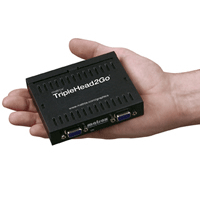Matrox TripleHead2Go Review
Ever since I first saw “Surround Gaming” using a Matrox Parhelia video card, I’ve been a huge fan. But sadly over the years, the Parhelia’s ability to perform with the latest games fell behind other graphics cards. Recently, I discovered that Matrox had developed the TripleHead2Go, a small external device known as a Graphics eXpansion Module. It enables you use three 19" monitors with a combined resolution of up to 3840x1024, with your PC (or laptop even) if that system only supports a single display output.
Well, was I excited or what? (I was. ^_^)
It seemed that Matrox had developed the one thing I had been dreaming of, for a long time. That is, the ability to play games in TripleHead (“Surround Gaming”) on pretty much any hardware... including SLi. After contacting Matrox they were kind enough to send me a unit to review for the forum. It arrived a few days ago and I've been in heaven ever since.




Desktop Usage
Windows spans the three screens beautifully without any mouse lag, and all the usual Window’s features work in the normal fashion. The only difference is that I now have three times the room for everything. The potential for increased productivity, by utilizing this huge workspace, is very apparent. I can have multiple applications open: MS Word on screen one, Internet Explorer on screen two and Outlook Express on screen three.
Or, I can have one application span the whole desktop - great for preparing widescreen screenshots for the forum. In Photoshop, for instance, you can have the various screenshots, photos, tools and previews on the different screens. Clearly the likes of game developers and CAD users will find huge benefits with this “Surround Design”, as Matrox calls it.
Configuring Surround Gaming
All the games on Matrox’s list of Supported Games (that I tried) were very easy to set up using the supplied Matrox Surround Gaming Utility . And, the utility has more that 100 titles predefined.
Most of us widescreen users are familiar with having to hack/edit configuration files: .ini and .cfg files. Well the SGU takes this one step further by creating a way to automatically configure the games to work in TripleHead from predefined “recipes,” so to speak. It supports user-defined updates of Surround Gaming "recipes" for games not on the Matrox Surround Gaming list. In this way, Matrox is enabling the user community to add support for additional games directly and contribute these back to the community. I actually managed to create a “recipe” for Splinter Cell – Chaos Theory a game not on the Matrox list, and the game works perfectly in TripleHead.
Just choose the TripleHead resolution for the game you want to run in Surround, and as I say, the SGU automatically configures the game for the best Surround experience. The available resolutions are: 3840x1024, 3072x768, 2400x600, and 1920x480. So depending on your hardware you can choose the best resolution to get the best in-game performance.
I see this tool could also be very useful for widescreen users as those “recipes” could provide the Widescreen Gaming community with a much easier/automated way to hack/edit those configuration files as the recipes don’t have to contain TripleHead resolutions. They could just as easily be widescreen resolutions as the usual things apply to Surround Gaming that applies to Widescreen Gaming … resolution/FOV/aspect ratio, etc. This is something I will have to discuss further with Matrox.


Scaling and Image Quality
The TripleHead2Go has a top resolution limit of 3840x1204, so I have been running all the games I tested at 3x1280x1024 (with at least 2x anti-aliasing) on my Dell 2001FP monitors which each have a native resolution of 1600x1200. I can honestly say that if you didn't know the resolution was up-scaled you probably wouldn't be able to tell - and they all looked great.
I ran one or two of the games at 1920x480 just to see how ugly it would be at the lowest resolution the TripleHead resolutions. And again, it really didn't look that bad (although I did turn up the anti-aliasing). Up-scaling on today's monitors really isn't bad, as the dot pitches on most monitors are very fine. I would go so far as to say that it can actually improve the look of some games by softening their hard edges and "look." I would suggest to anyone that hasn't tried up-scaling on there monitors to give it a try, you may be surprised at the quality.
